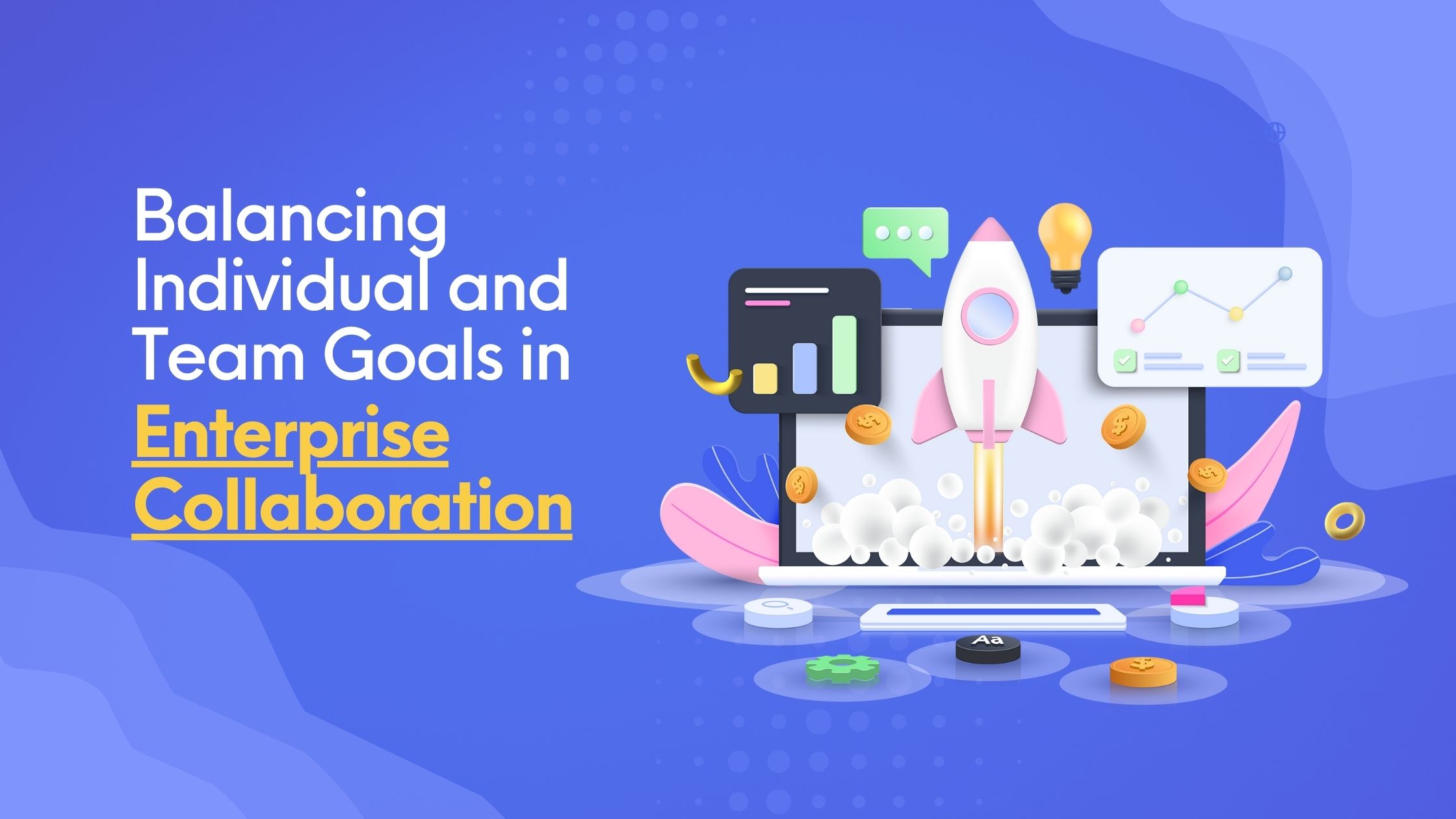Striking a Balance Between Individual and Team Goals
- Role of collaboration in balancing individual and team goals
- What are the individual goals in enterprise collaboration?
- What are the team goals in enterprise collaboration?
- Why do you need to strike a balance?
- A win-win situation
It goes without saying that a contented workforce contributes to a prosperous organization. It is a triumph for us employers when we are able to foster a supportive and positive work environment for our team.
I strongly believe that we shouldn’t back out in offering optimum support to employees so that they can strike a balance between their personal and organizational goals.
It is essential to understand the dynamics of your team and help them in mending the loopholes while promoting positive relationships, communication, and collaboration.
Collaboration is a vital aspect of any enterprise, and it involves individuals working together toward a common goal. It helps create a healthy work environment by fostering teamwork, building trust and respect, increasing creativity and innovation, and boosting morale and engagement.
Pursuing the same thought, I would like to explore in depth the role of collaboration in balancing individual and team goals. Let’s go!
Individual Goals in Enterprise Collaboration
Individual goals in enterprise collaboration are critical. When individuals are motivated to achieve their goals, they can bring their best efforts to the team, which ultimately benefits the organization.
Integrating collaboration is imperative to achieve individual goals. It is not only important for fostering a positive work environment but also for helping employees achieve their individual goals. When employees collaborate, they can share their knowledge and expertise with each other, which can help them develop new skills and achieve their personal goals effectively.
Some individual goals in enterprise collaboration may include:
Understand the big picture: Before setting individual goals, it is required for the employees to have a clear understanding of the company’s mission and goals, set team goals, share progress updates, and seek feedback and guidance. This will help them in setting feasible personal objectives that align with the organizational goals. Thus, it would be a win-win situation in both scenarios.
Improve personal skills: Encouraging employees to reflect on their personal skills and set goals for improvement can be an effective way to foster personal growth and development. When employees collaborate among the team, they share their knowledge, expertise, and experience with each other. This may help individuals develop new skills such as communication, problem-solving, and critical thinking. Moreover, employers can help in achieving so by offering relevant training and development programs, online courses, workshops, or mentoring programs.
Set specific and measurable goals: Setting specific and measurable goals is crucial to attaining success because it helps to clarify what individuals want to achieve, create a roadmap for accomplishing it, and track your progress along the way. By breaking down larger goals into smaller ones, architecting more manageable objectives, and measuring progress towards those objectives, employees can stay on track and make adjustments as needed to hit the bull’s eye.
Prioritize and take ownership of goals: Prioritizing and taking ownership of goals requires setting SMART goals in the first place, communicating goals with the team, breaking down goals into actionable steps, holding oneself accountable, and collaborating with others. By taking ownership of their goals and collaborating effectively with their team, employees can achieve their individual goals while contributing to the success of the team and the organization.
Read More: Decoding the Virtual Workplace Culture
Team Dynamics and Goals in Enterprise Collaboration
While individual goals are essential, employees and managers must also strategize to align with the team’s goals for effective collaboration. Integrating collaboration is imperative in achieving team goals because it enables team members to work together towards a shared objective, leverage each other’s strengths, and achieve more than they could individually.
Collaboration is critical in achieving organizational goals and strengthening team dynamics because it combines diverse perspectives and expertise, increases efficiency and productivity, builds trust and strengthens relationships, encourages innovation, and improves problem-solving. By collaborating effectively, teams can achieve their shared objectives and contribute to the success of the organization.
Some more team goals in enterprise collaboration may include:
Alignment with the company’s objectives: Team members should have a clear understanding of the company’s objectives and how their team’s goals contribute to achieving them. This involves creating specific, measurable, achievable, relevant, and time-bound (SMART) goals that align with the company’s broader objectives. It can be achieved by ensuring that the team goals are streamlined with the enterprise’s mission, vision, and strategic objectives. Employers can also promote conducting brainstorming sessions, reviewing business objectives, or analyzing market trends to ensure alignment with the company’s objectives.
Measurable and specific: Make sure that the goals are measurable and specific so that it would be easier to track the progress. Setting clear metrics is a great strategy to determine whether the goal has been achieved or not. For example, if the goal is to increase customer satisfaction, specific metrics could include customer survey scores or repeat business rates. Having discussion sessions among teams regarding setting feasible goals while evaluating multiple factors in mind is also a great idea.
Collaborative approach: Team goals should be developed in a collaborative manner, with input from all team members. This not only helps to ensure that the goal is realistic and achievable but also fosters a sense of ownership and commitment among team members. Team managers should make sure that activities like brainstorming sessions, team meetings, and other group activities are conducted to integrate collaboration into the daily work routine.
Flexibility and adaptability: While it’s important to have a clear goal in mind, it’s also important to make that goal flexible and adaptable. Given the ever-changing market we are in, circumstances may change, priorities may shift, and unexpected challenges may arise. Thus, team goals should be flexible enough to have room for adjustments so that employers can keep the team on track.
Regular review and feedback: Employers must ensure regulating progress by setting up regular check-ins to assess progress, provide feedback, and make adjustments as needed. Recurrent reviews and feedback will help to keep the team motivated and focused on the goal.
Turning failure into success: When it comes to the word ‘failure’, a sense of negativity also tags along with it. However, why ‘failure is the best teacher’ is unknown to many. Failure can be a valuable tool in a team’s learning and growth process. When a team is not able to achieve certain targets, valuable feedback and insights come in handy to improve performance and gradually achieve success in the future. By analyzing and identifying what went wrong, the team can adjust their strategy and approach, which can lead to better outcomes in the future.
Additionally, failure can create a sense of urgency and motivate the team to take action and make changes to improve their performance. This sense of urgency can also lead to increased collaboration, communication, and innovation within the team. As the team works together to learn from their failures, they may be more likely to try new approaches and ideas that they may not have considered before. This can encourage experimentation, leading to new insights and breakthroughs that can help the team achieve success in the future.
Celebrate success: While it is important to address low points and even celebrate failure, it is equally vital to appreciate and celebrate success to keep the team motivated and engaged. Even a small success at the workplace should be perceived as a milestone, that will induce greater motivation. When team and organizational goals are achieved, it’s imperative to take the time to recognize the hard work and effort that went into achieving the goal.
It’s always good to share your happiness with people around you who are happy about your achievements. Celebrations may include but are not limited to team outings, recognition ceremonies, team discussions over drinks while analyzing the performance, or other fun activities. Teams may express gratitude even through little actions. For example, receiving a card from colleagues on achieving targets can bring happiness and a sense of camaraderie. Teams can also conduct a 10-minute session to recognize and appreciate each other’s efforts and kickstart the day with great motivation and positivity.
By implementing the key points mentioned above, organizations can set effective team goals in enterprise collaboration that align with the company’s objectives, engage team members, and drive success.
Read More: Understanding the Paradigm Shift in Work Culture Post-pandemic
The Pressing Need of Striking a Balance Between Individual and Team Goals
While individual goals are important in helping employees achieve their personal objectives and career aspirations, team goals are critical in achieving the broader objectives of the organization. Striking the right balance between individual and team goals is essential to ensure that employees remain motivated, engaged, and productive while contributing to the success of the organization.
Here are some ways through which we can support employees to balance their personal and team goals via collaboration:
Establish clear team goals: Establishing clear team goals while balancing individual and organizational goals in enterprise collaboration can be challenging, but it’s essential for success. Start by clearly defining the team’s purpose, mission, and objectives. This can help ensure that everyone is working towards a common goal and understands how their individual contributions fit into the larger picture. Furthermore, employers may ensure identifying individual and team goals, aligning goals with company objectives, setting SMART (Specific, Measurable, Attainable, Relevant, and Time-bound) goals, monitoring progress, and encouraging communication and collaboration.
Communicate the importance of both individual and team goals: It is essential to communicate to team members the importance of both individual and team goals. This helps to create a shared understanding of the value of each type of goal and how they work together to achieve overall success.
Involve team members in setting individual goals: Team members should be involved in setting their individual goals. This ensures alignment of goals while encouraging the team members to feel ownership and take responsibility for their goals.
Encourage collaboration and knowledge sharing: Collaboration and knowledge sharing among team members can help balance individual and team goals. By working together, team members can support each other in achieving their individual goals while also contributing to the team’s goals.
Provide regular feedback: Regular feedback is essential to ensure that team members are on track to achieve their individual and team goals. This feedback can be provided through regular team meetings, individual performance reviews, or other communication channels.
Try implementing these strategies in your business to balance individual and team goals and you will experience that each team member is contributing to the overall success of the team while also achieving their individual goals.
A win-win situation, isn’t it?
Share your thoughts in the comment section below!







